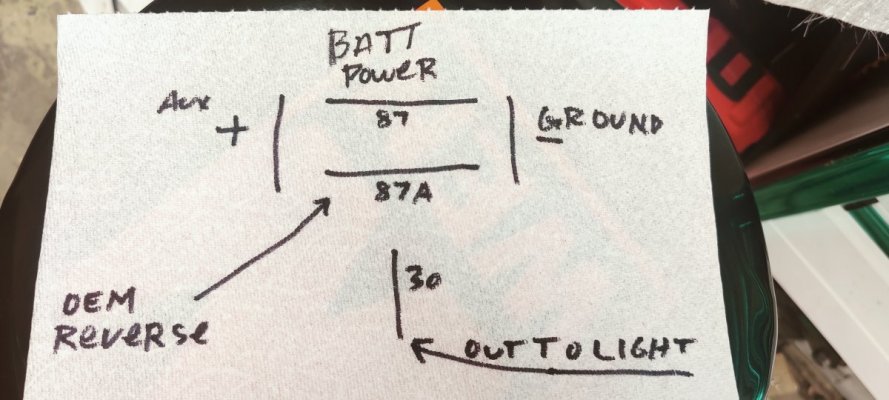guess its time to have a thread dedicated to wiring, and wiring a relay. keep seeing people struggle with them.
a relay is basically a switch. its a switch powered by an electromagnet. there are several different types of relays, but the most common relays we use are spst (single pole, single throw. ie 4post relays) and spdt (single pole double throw. ie 5post relays). these come in usually 30-40 amps depending on manufacturer. an spdt relay (5post) can be used as an spst (4post) relay, but an spst can NOT be used as an spdt. the big difference between the relays is that the spst is just an on off switch. there is no 87a (center post) all it does is turn things on or off. lights for example. if you are using your factory switches you will notice that the amperage is not enough for a 40in lightbar, thats where a relay comes into play. depending on how you want to wire up your lights, will determine which relay you want. just on and off with an aux switch (or any other trigger) will be a spst. or like my reverse lights which come on automatically, but can also use a switch to activate when not in reverse. this uses a spdt. however most of the time a spdt relay is the same cost as an spst relay. on to the good bits now.
i unfortunately dont have an spst relay, but i will find one to take a pic, but essentially the difference is it does not have a center post.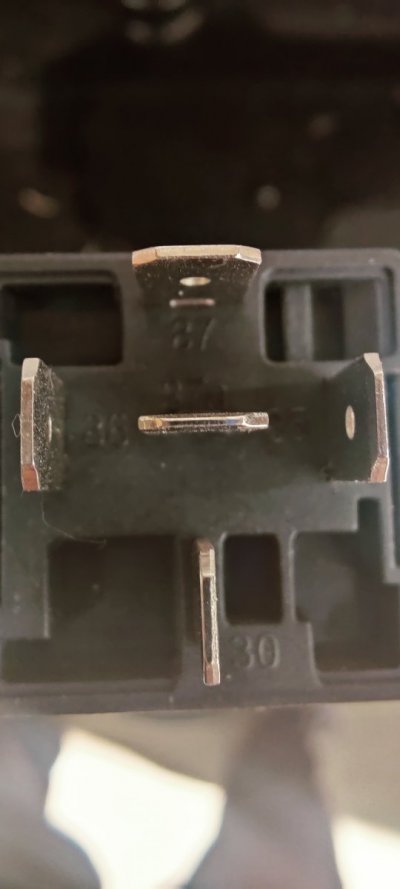 here is an spdt relay.
here is an spdt relay. 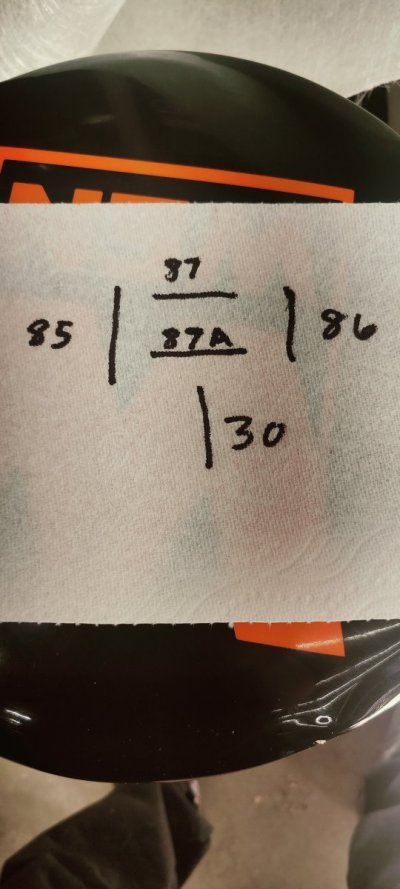 this is a diagram of the post layout. 85 and 86 get power and ground. so lets say you are using an aux switch in the truck, it is 12v so its a positive trigger. if you connect 85 from the aux switch, you must connect 86 to ground. sometimes you have a negative trigger so lets say you are using (not recommended by the way. for example purposes only) a high beam switch and its a negative trigger meaning a gound signal, if you connect that to 85, you must connect 86 to power. power and ground do not have a dedicated side on a relay. take a 9v battery. touch it to 85 and 86. then flip the battery around and touch it again. the relay still activates regardless. i have always wired relays a certain way just due to the installer in me and how we use relays. i alaays use 85 as source signal input (aux, or any trigger im using) then 86 as opposite so the relay itself has power and ground. i always use 30 as output to my lights compressors, etc. confusing? just think that one side needs power, the other side needs ground. thats it. now to get more confusing.....
this is a diagram of the post layout. 85 and 86 get power and ground. so lets say you are using an aux switch in the truck, it is 12v so its a positive trigger. if you connect 85 from the aux switch, you must connect 86 to ground. sometimes you have a negative trigger so lets say you are using (not recommended by the way. for example purposes only) a high beam switch and its a negative trigger meaning a gound signal, if you connect that to 85, you must connect 86 to power. power and ground do not have a dedicated side on a relay. take a 9v battery. touch it to 85 and 86. then flip the battery around and touch it again. the relay still activates regardless. i have always wired relays a certain way just due to the installer in me and how we use relays. i alaays use 85 as source signal input (aux, or any trigger im using) then 86 as opposite so the relay itself has power and ground. i always use 30 as output to my lights compressors, etc. confusing? just think that one side needs power, the other side needs ground. thats it. now to get more confusing.....
on an spdt relay, 87a and 30 are normally closed. meaning when the relay does not have power, the circuit goes through.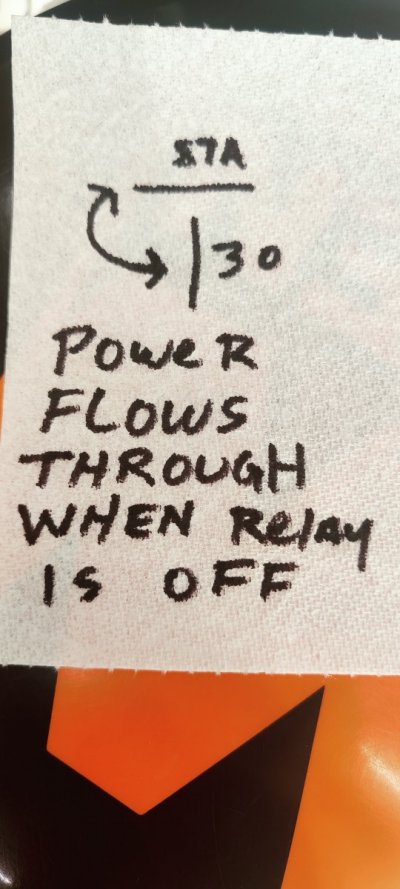 when the relay has power 87 and 30 are common, which means they are connected and that makes a complete circuit. also known as a normally open circuit. its disconnected until power is applied to the relay
when the relay has power 87 and 30 are common, which means they are connected and that makes a complete circuit. also known as a normally open circuit. its disconnected until power is applied to the relay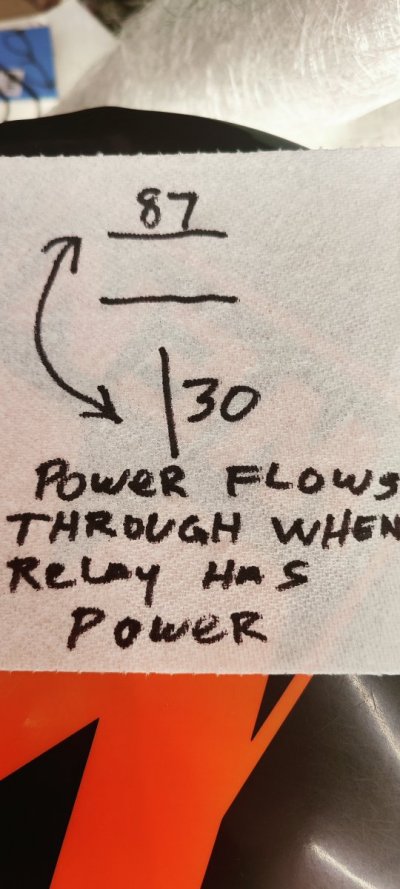 when wired this way, 87 (or 30) is usually battery power. heavier wire from the battery itself. a relay activated on roughly 200ma of current. so lets say aux 4 (gen 1) is a 5 amp circuit. there is no way i can power my 4 air compressors on 5 amps of current. each compressor is 25 amps. so i got 100amp of current i need to power from a 5amp aux switch. well with the relay being 30-40 amp capable, i can do just that. at 200ma (milliamps) i can power 5 relays at 1amp draw from my aux switch. and at 5 amps, that technically 25 relays i can power from that aux switch. however i highly recommend to not do that. maybe keep it to 20 relays. 4 amps of current. but we will discuss that later. so now that i have completely lost you, lets wire up a relay to power a light bar. this is an spst circuit, using an spdt relay. meaning we are not using the center post. or you already have a relay without a center post (spst)
when wired this way, 87 (or 30) is usually battery power. heavier wire from the battery itself. a relay activated on roughly 200ma of current. so lets say aux 4 (gen 1) is a 5 amp circuit. there is no way i can power my 4 air compressors on 5 amps of current. each compressor is 25 amps. so i got 100amp of current i need to power from a 5amp aux switch. well with the relay being 30-40 amp capable, i can do just that. at 200ma (milliamps) i can power 5 relays at 1amp draw from my aux switch. and at 5 amps, that technically 25 relays i can power from that aux switch. however i highly recommend to not do that. maybe keep it to 20 relays. 4 amps of current. but we will discuss that later. so now that i have completely lost you, lets wire up a relay to power a light bar. this is an spst circuit, using an spdt relay. meaning we are not using the center post. or you already have a relay without a center post (spst)
pretty simple. 85 gets power from aux switch. 86 goes to ground. 87 is power from battery and 30 is out to your light. YOU DO NOT USE 87A (center post) on this setup. keep in mind 85 and 86 are interchangeable, meaning they can accept both power and ground (as explained earlier) and 87 and 30 are interchangeable. meaning you can use 30 as input from power and 87 out to the lights. it doesnt matter. some manufacturers say use 30 in from battery, and 87 out to lights. no difference in this setup. (however i have always ran relays as 30 output since the next set of diagrams for reverse lights need specific connections) but get in the habit of always wiring relays the same way. makes it much easier when wiring multiple relays together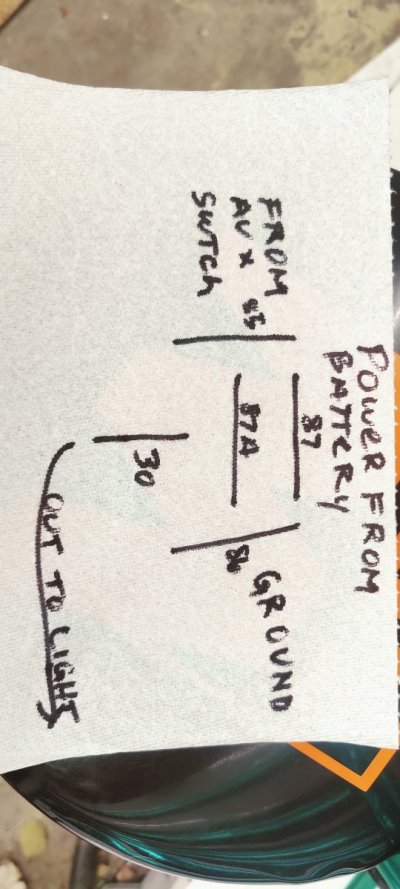 sorry for the sideways pic.
sorry for the sideways pic.
next topic. spdt relays and now to use them correctly.
a relay is basically a switch. its a switch powered by an electromagnet. there are several different types of relays, but the most common relays we use are spst (single pole, single throw. ie 4post relays) and spdt (single pole double throw. ie 5post relays). these come in usually 30-40 amps depending on manufacturer. an spdt relay (5post) can be used as an spst (4post) relay, but an spst can NOT be used as an spdt. the big difference between the relays is that the spst is just an on off switch. there is no 87a (center post) all it does is turn things on or off. lights for example. if you are using your factory switches you will notice that the amperage is not enough for a 40in lightbar, thats where a relay comes into play. depending on how you want to wire up your lights, will determine which relay you want. just on and off with an aux switch (or any other trigger) will be a spst. or like my reverse lights which come on automatically, but can also use a switch to activate when not in reverse. this uses a spdt. however most of the time a spdt relay is the same cost as an spst relay. on to the good bits now.
i unfortunately dont have an spst relay, but i will find one to take a pic, but essentially the difference is it does not have a center post.
 here is an spdt relay.
here is an spdt relay.  this is a diagram of the post layout. 85 and 86 get power and ground. so lets say you are using an aux switch in the truck, it is 12v so its a positive trigger. if you connect 85 from the aux switch, you must connect 86 to ground. sometimes you have a negative trigger so lets say you are using (not recommended by the way. for example purposes only) a high beam switch and its a negative trigger meaning a gound signal, if you connect that to 85, you must connect 86 to power. power and ground do not have a dedicated side on a relay. take a 9v battery. touch it to 85 and 86. then flip the battery around and touch it again. the relay still activates regardless. i have always wired relays a certain way just due to the installer in me and how we use relays. i alaays use 85 as source signal input (aux, or any trigger im using) then 86 as opposite so the relay itself has power and ground. i always use 30 as output to my lights compressors, etc. confusing? just think that one side needs power, the other side needs ground. thats it. now to get more confusing.....
this is a diagram of the post layout. 85 and 86 get power and ground. so lets say you are using an aux switch in the truck, it is 12v so its a positive trigger. if you connect 85 from the aux switch, you must connect 86 to ground. sometimes you have a negative trigger so lets say you are using (not recommended by the way. for example purposes only) a high beam switch and its a negative trigger meaning a gound signal, if you connect that to 85, you must connect 86 to power. power and ground do not have a dedicated side on a relay. take a 9v battery. touch it to 85 and 86. then flip the battery around and touch it again. the relay still activates regardless. i have always wired relays a certain way just due to the installer in me and how we use relays. i alaays use 85 as source signal input (aux, or any trigger im using) then 86 as opposite so the relay itself has power and ground. i always use 30 as output to my lights compressors, etc. confusing? just think that one side needs power, the other side needs ground. thats it. now to get more confusing.....on an spdt relay, 87a and 30 are normally closed. meaning when the relay does not have power, the circuit goes through.
 when the relay has power 87 and 30 are common, which means they are connected and that makes a complete circuit. also known as a normally open circuit. its disconnected until power is applied to the relay
when the relay has power 87 and 30 are common, which means they are connected and that makes a complete circuit. also known as a normally open circuit. its disconnected until power is applied to the relay when wired this way, 87 (or 30) is usually battery power. heavier wire from the battery itself. a relay activated on roughly 200ma of current. so lets say aux 4 (gen 1) is a 5 amp circuit. there is no way i can power my 4 air compressors on 5 amps of current. each compressor is 25 amps. so i got 100amp of current i need to power from a 5amp aux switch. well with the relay being 30-40 amp capable, i can do just that. at 200ma (milliamps) i can power 5 relays at 1amp draw from my aux switch. and at 5 amps, that technically 25 relays i can power from that aux switch. however i highly recommend to not do that. maybe keep it to 20 relays. 4 amps of current. but we will discuss that later. so now that i have completely lost you, lets wire up a relay to power a light bar. this is an spst circuit, using an spdt relay. meaning we are not using the center post. or you already have a relay without a center post (spst)
when wired this way, 87 (or 30) is usually battery power. heavier wire from the battery itself. a relay activated on roughly 200ma of current. so lets say aux 4 (gen 1) is a 5 amp circuit. there is no way i can power my 4 air compressors on 5 amps of current. each compressor is 25 amps. so i got 100amp of current i need to power from a 5amp aux switch. well with the relay being 30-40 amp capable, i can do just that. at 200ma (milliamps) i can power 5 relays at 1amp draw from my aux switch. and at 5 amps, that technically 25 relays i can power from that aux switch. however i highly recommend to not do that. maybe keep it to 20 relays. 4 amps of current. but we will discuss that later. so now that i have completely lost you, lets wire up a relay to power a light bar. this is an spst circuit, using an spdt relay. meaning we are not using the center post. or you already have a relay without a center post (spst)pretty simple. 85 gets power from aux switch. 86 goes to ground. 87 is power from battery and 30 is out to your light. YOU DO NOT USE 87A (center post) on this setup. keep in mind 85 and 86 are interchangeable, meaning they can accept both power and ground (as explained earlier) and 87 and 30 are interchangeable. meaning you can use 30 as input from power and 87 out to the lights. it doesnt matter. some manufacturers say use 30 in from battery, and 87 out to lights. no difference in this setup. (however i have always ran relays as 30 output since the next set of diagrams for reverse lights need specific connections) but get in the habit of always wiring relays the same way. makes it much easier when wiring multiple relays together
 sorry for the sideways pic.
sorry for the sideways pic.next topic. spdt relays and now to use them correctly.


